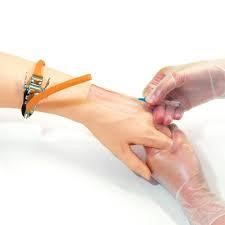A nurse is assessing the peripheral catheter insertion site of a client who is receiving an infusion. The nurse notices redness and warmth to the touch around the insertion site. The nurse should document the finding as which of the following complications?
Infiltration
Extravasation
Circulatory overload
Phlebitis
The Correct Answer is D
Choice A reason:
Infiltration is not correct: Infiltration occurs when the infused fluid or medication leaks into the surrounding tissue instead of flowing into the vein. This can lead to swelling, coolness, and pallor around the insertion site.
Choice B reason:
Extravasation is not correct: Extravasation is similar to infiltration but specifically refers to the infiltration of vesicant medications, which can cause tissue damage and necrosis.
Choice C reason:
Circulatory overload is not correct: Circulatory overload occurs when a large volume of fluid is infused too quickly, overloading the circulatory system and potentially leading to fluid overload, pulmonary edema, and other related symptoms.
Choice D reason:
Phlebitis is the appropriate fingings. The nurse should document the finding of redness and warmth around the peripheral catheter insertion site as phlebitis. Phlebitis is the inflammation of a vein, often caused by mechanical irritation, chemical irritation, or infection. In this case, the redness and warmth at the insertion site are indicative of inflammation, which is a common sign of phlebitis.

Nursing Test Bank
Naxlex Comprehensive Predictor Exams
Related Questions
Correct Answer is A
Explanation
The correct answer is A. A client who has a spinal cord injury requires an interprofessional approach to care that involves multiple disciplines such as physical therapy, occupational therapy, social work, and rehabilitation nursing. The other clients have less complex needs that can be managed by one or two disciplines.
Correct Answer is A
Explanation
The correct answer is A. Administer the client's formula at room temperature. The nurse should administer the formula at room temperature to reduce gastrointestinal motility and prevent diarrhea.
Whether you are a student looking to ace your exams or a practicing nurse seeking to enhance your expertise , our nursing education contents will empower you with the confidence and competence to make a difference in the lives of patients and become a respected leader in the healthcare field.
Visit Naxlex, invest in your future and unlock endless possibilities with our unparalleled nursing education contents today
Report Wrong Answer on the Current Question
Do you disagree with the answer? If yes, what is your expected answer? Explain.
Kindly be descriptive with the issue you are facing.
